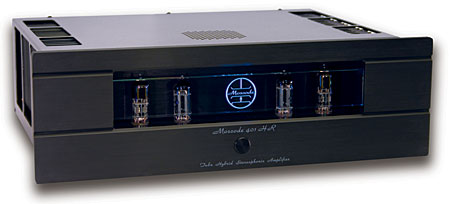| Columns Retired Columns & Blogs |
Moscode 401HR power amplifier
Where does one start with the Moscode 401HR? With its design, which marries a tube driver stage to a MOSFET power output? Or perhaps with its designer, George Kaye, who refined Julius Futterman's OTL amplifier circuits before creating New York Audio Labs' original hybrid amplifier, the Moscode 300, in 1984?

Perhaps the most logical place to start is with the 401's "HR" designation, which honors the late Harvey "Gizmo" Rosenberg, a true audio original: champion of the Futterman OTL legacy, founder of New York Audio Labs, and patron and inspiration for George Kaye's forays into the Moscode ethos. Rosenberg hated the commoditization of hi-fi, which led to products sounding more and more like one another. Instead, he threw himself wholeheartedly into audio technology that had soul—he didn't care whether a component was practical as long as it induced passion. In the original owner's manual for the Moscode 300, lovingly included as an appendix to the 401HR's comprehensive manual, Rosenberg described a purification ritual that included warm baths, cold showers, massage, silk robes, and ritual infusions of herbs and strong drink—all to prepare the new owner to unpack the new component.
You're probably rolling your eyes at that. I did when I first read it—but I also understood what Rosenberg meant. These days, our lives present few occasions for ritual; but when you spend $4995 on a component like the 401HR (or $899 for the 300 in 1984 dollars), experiencing it for the first time ought to be special. And make no mistake—you will want to mark the entrance of the Moscode 401HR into your system with some degree of pomp and circumstance.
The ear should remain the first and last court of appeal
No one could doubt that the 401HR has tubes. George Kaye has mounted them right up front behind an etched glass panel with a glowing blue logo. The amp comes with pairs of 6H30Pi dual-triode and 6GU7 dual-triode tubes, although many other small triodes can be used. Kaye suggests that switching the voltage-gain tubes (the ones on the outer edges of the tube array) will create the most noticeable differences, and he has designed the 401HR so that it powers down when its faceplate is opened, and back up when it's closed.
The 401HR also has an Auto Filament Switcher that detects center-tapped filament tubes (such as the 12AU7) and switches from a two- to a three-pin filament circuit. That's in keeping with Kaye's contention that the 401HR is "tubes without the anxiety; tubes without the overhead." The 401HR's wide range of usable tubes means that consumers can rest assured of being able to employ pretty much any available dual triode, and the amp's auto-sensing and auto-biasing circuits will remove most of the fiddle factor.
That's the Cliff Notes version. Kaye also emphasizes good circuit layout that places the output-stage transistors and the power supply all on a single circuit board with short signal paths and wide traces ("lots of copper"), as well as extensive power regulation "that allows the tubes' voltage swing to go way past what the output stage can do, which means no compression," and "exceptional" capacitors in its output stage. Kaye is voluble on that last point: "The Moscode 300 had about 31,000µF of storage capacity; this has 176,000µF—let's say 88,000µF per channel. That lowers the output impedance of the power supply, so the negative feedback loop's not working to make up for losses. It's not straining to get power to your speakers, which is why it has such effortless presentation."
For the extended-play version of the 401HR's technical specs, check out Moscode's website. While you're there, you'll note that the 401HR is for sale only via the website, and is temporarily for sale at $4995, with a 331/3-day guarantee of satisfaction or your money back.
Don't play what's there, play what's not there
Setting up the 401HR is not difficult, though you do have to insert the tubes yourself. If you've never done this before, it's never that big a deal, and the 401HR's flip-down tube door makes it even simpler—as long as you put the 6H30Pi and the 6CG7 tubes in their mirrored positions. (Just read the labels on the tube boxes, which tell you which socket to put each tube in—even guys can read the manual.)
You'll also discover that the 401HR comes equipped with Edison-Price binding posts, which, in addition to being made of unplated, great-sounding copper, are refreshingly simple to tighten with your fingers.
- Log in or register to post comments




































